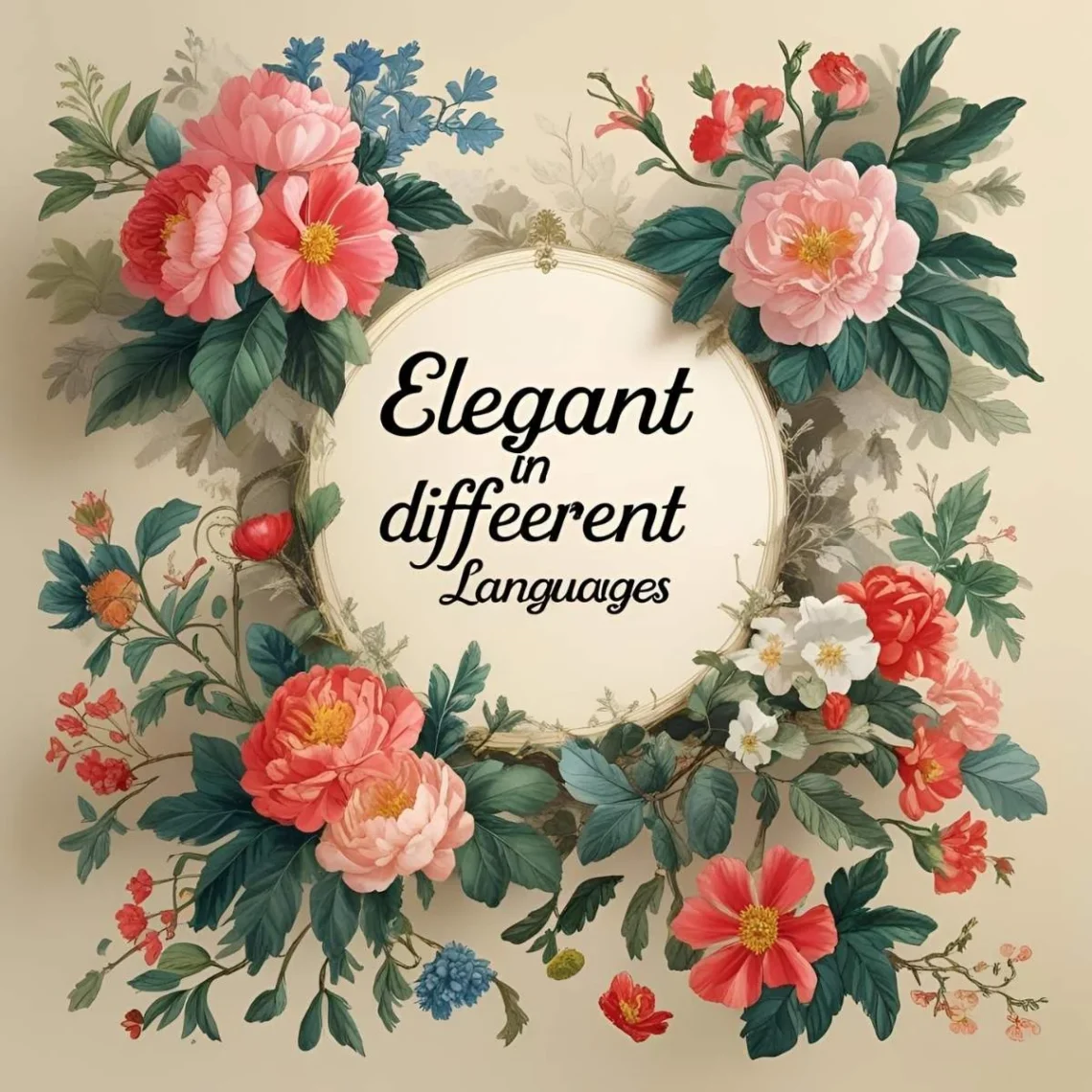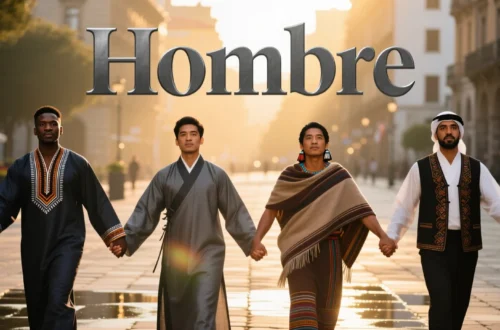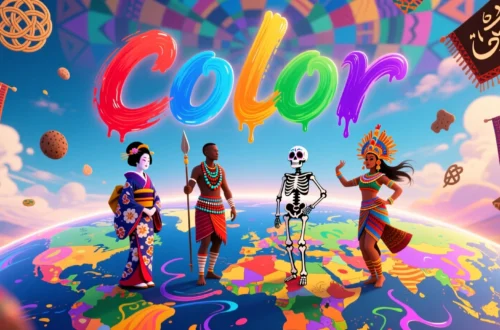Picture a woman gliding through a Paris ballroom, her dress shimmering as someone whispers “élégante.” That word, “elegant,” captures a universal admiration for grace and refinement, yet it dances differently across languages and cultures.
Whether it’s “anmutig” in a Berlin café or “zarif” in an Istanbul bazaar, the term for “elegant” reflects humanity’s shared appreciation for beauty, shaped by unique cultural lenses.
Let’s embark on a global journey to explore how people express “elegant” and what these words reveal about their societies.
Reference Table: “Elegant” in Different Languages
| Language | Word/Phrase | Cultural/Linguistic Insight |
|---|---|---|
| French | Élégant | Evokes sophistication, tied to France’s fashion legacy. |
| Spanish | Elegante | Suggests refined style, used for people or aesthetics. |
| Italian | Elegante | Reflects Italy’s love for artful beauty and poise. |
| German | Anmutig | Means “graceful,” emphasizing natural charm. |
| Mandarin | Yōuyǎ (优雅) | Means “graceful beauty,” tied to harmony and poise. |
| Hindi | Shishta | Implies refined manners, rooted in cultural respect. |
| Japanese | Yūga (優雅) | Suggests refined grace, often linked to traditional arts. |
| Korean | Uahan (우아한) | Means “graceful,” reflecting understated elegance. |
| Arabic | Zarif (ظريف) | Means “refined” or “charming,” used across 20+ countries. |
| Swahili | Faini | Means “fine” or “beautiful,” used for style and grace. |
| Zulu | Bukhali | Implies sharp beauty or elegance, used in South Africa. |
| Yoruba | Ẹlẹwà | Means “beautiful” or “elegant,” tied to inner grace. |
| Maori | Whakapaipai | Suggests adornment and beauty, linked to cultural pride. |
| Hawaiian | Nani | Means “beautiful,” often used for elegant aesthetics. |
| Cherokee | Adanvdo | Implies a refined spirit, used for graceful presence. |
European Languages: Grace with a Cultural Flair
European languages express “elegant” with terms that blend sophistication and cultural values. For instance, in French, “élégant” evokes the polished charm of Parisian fashion, used for both people and refined settings. Meanwhile, Spanish speakers say “elegante,” a term that captures stylish poise, often heard in Madrid’s vibrant plazas. Additionally, Italian uses “elegante,” reflecting Italy’s passion for art and beauty, as seen in Florence’s grand designs. In German, “anmutig” (graceful) emphasizes natural charm, aligning with Germany’s appreciation for understated refinement. Thus, these words showcase Europe’s blend of bold sophistication and subtle grace, from France’s haute couture to Germany’s quiet elegance.
Asian Languages: Harmony in Refinement
Asia’s linguistic diversity shapes unique terms for “elegant,” often tied to harmony and culture. For example, in Mandarin, “yōuyǎ” (graceful beauty) reflects China’s emphasis on balance, used to describe poised individuals or serene aesthetics. In Hindi, “shishta” implies refined manners, rooted in India’s respect for decorum, often heard in Delhi’s cultural circles. Similarly, Japanese uses “yūga” (refined grace), evoking the elegance of tea ceremonies or kimono-clad figures. In Korean, “uahan” (graceful) conveys understated beauty, aligning with South Korea’s minimalist aesthetic. Finally, Arabic’s “zarif” (refined), used across over 20 countries like Egypt and Lebanon, suggests charm and wit, tied to the region’s poetic heritage. These terms highlight Asia’s spectrum, from serene grace to vibrant refinement.
African Languages: Elegance in Community
African languages tie “elegant” to beauty and communal pride. For instance, Swahili, spoken in over 20 countries like Kenya and Tanzania, uses “faini” (fine or beautiful), a term for stylish grace in vibrant markets or celebrations. In Zulu, “bukhali” (sharp beauty) conveys striking elegance in South Africa, often used for poised individuals. Similarly, Yoruba’s “ẹlẹwà” (beautiful or elegant) in Nigeria emphasizes inner grace, reflecting cultural values of dignity. These terms, shared in communal settings, highlight Africa’s celebration of elegance as both personal and collective.
Indigenous & Island Languages: Beauty in Tradition
Indigenous and island languages express “elegant” with simplicity and cultural depth. For example, Maori in New Zealand uses “whakapaipai” (adornment), reflecting beauty tied to cultural pride, as seen in traditional attire. In Hawaiian, “nani” (beautiful) conveys elegance with the spirit of aloha, used for graceful people or settings. Similarly, Cherokee’s “adanvdo” implies a refined spirit, used in Native American communities for those with graceful presence. In Samoan, “lelei” (good or beautiful) reflects elegance in communal contexts, often tied to rituals. Across these cultures, from New Zealand to the Cherokee Nation, “elegant” emphasizes beauty rooted in tradition and connection.
Cultural Insights: The Evolution of Elegance
Words for “elegant” have evolved with cultural values. For instance, French “élégant” traces to 17th-century European courts, where style defined status. In Arabic, “zarif” emerged from medieval poetry, symbolizing refined wit. Moreover, in African languages like Yoruba, “ẹlẹwà” reflects spiritual beauty, tied to rituals. In Asia, terms like “yūga” align with philosophies of harmony, seen in Japan’s traditional arts. These words carry histories of art, status, and spirituality, uniting cultures in their admiration for grace and refinement.
Proverbs and Sayings: Wisdom of Elegance
- French: “L’élégance est la beauté qui ne fane jamais.” (Elegance is beauty that never fades.) – Highlights timeless grace.
- Hindi: “Shishta jeevan sundar jeevan hai.” (A refined life is a beautiful life.) – Ties elegance to manners.
- Swahili: “Faini ni roho ya uzuri.” (Elegance is the soul of beauty.) – Links grace to inner qualities.
- Japanese: “Yūga wa kokoro no kagami.” (Elegance is the mirror of the heart.) – Emphasizes inner refinement.
- Yoruba: “Ẹlẹwà ni ipilẹ ayọ.” (Elegance is the foundation of joy.) – Connects grace to happiness.
FAQs
Why do some words for “elegant” sound similar?
Shared linguistic roots (e.g., Latin-based “elegante” in Spanish and Italian) and cultural exchanges (e.g., Arabic’s “zarif” influencing Swahili) create similarities.
What’s the oldest term for “elegant”?
Latin’s “elegans” (circa 1st century BCE), meaning “refined,” is an early root, influencing Romance languages.
How do cultures shape the term’s use?
Collectivist cultures (e.g., African, Indigenous) tie elegance to community pride, while individualistic cultures (e.g., European) focus on personal style.
Conclusion
From “élégant” in France to “faini” in Tanzania, the word for “elegant” weaves a global thread of grace and beauty. Each term, whether the serene “yūga” in Japanese or the proud “whakapaipai” in Maori, reflects cultural values while celebrating our shared admiration for refinement. Consequently, these words remind us that elegance transcends borders, uniting all people in a universal nod to grace. How do you say “elegant” in your language, and what does it mean to you? Share your thoughts below—we’d love to hear your story!






